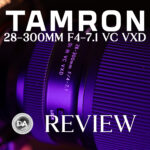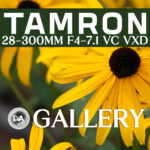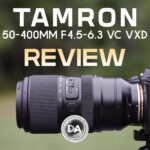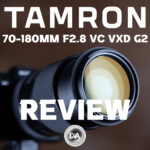
Tamron 50-300mm F4.5-6.3 VC VXD Review
Tamron has been working through their early zoom lenses for Sony E-mount with new G2 versions. These typically involve more features, beautiful build quality, and often a focus motor upgrade (from the earlier RXD focal motors to the higher powered VXD motors). Tamron’s newest lens doesn’t carry a G2 designation, because, while all of those previous things are true of it, they’ve also expanded the zoom range to make an entirely new zoom lens. I reviewed the predecessor of this lens (the Tamron 70-300mm F4.5-6.3 RXD) back in 2020, and concluded that it focused well and had great image quality, but it lacked any features (including a zoom lock) and could use lens based stabilization. Tamron must have agreed, as the new Tamron 50-300mm F4.5-6.3 Di III VC VXD is more feature rich, has a nicer build, has a zoom lock, and has image stabilization as well. It has a ton of other upgrades as well, making this a very attractive and slightly upmarket alternative to the previous lens. It’s also priced a little higher $799 USD, but still offers a very strong value relative to competing lenses. So is it worth buying? Find out in my video review below or by reading on here.
Follow Me @ YouTube | Patreon | Instagram | Facebook | DA Merchandise | Flickr | 500px | X
Thanks to Tamron USA for sending me a review loaner of this lens. As always, this is a completely independent review. *The tests and most of the photos that I share as a part of my review cycle have been done with the Sony a7RV along with the Sony Alpha 1 that serve as my benchmark cameras for Sony lenses.
__________________________________________________________________________________________________
Tamron’s lens names tend to be long and descriptive…but not necessarily clear to the uninitiated. Here’s what all of those letters mean:
- Di III = Designed for mirrorless (in this case, Sony E-mount, though expect a Nikon Z and perhaps even a Fuji X-mount version in the future).
- VC = Vibration Compensation, Tamron’s in lens stabilization system
- VXD = Voice-coil eXtreme-torque Drive (a linear focus motor)

Here are the standout features of the new lens:
- Expanded zoom range (6x zoom ratio)
- Vibration Compensation
- Custom/function button
- Weather sealed USB-C port for firmware updates and customization through Tamron’s Lens Utility software
- Zoom lock
- 1:2 macro performance at 70mm (0.50x) | also achieves 0.32x magnification at 300mm
- Weather resistance
- High powered VXD focus motor
- Improved image quality
There’s a lot of serious improvements to this design, and while the price tag has grown by $250 over the previous lens, this is a much more premium lens with a lot of serious upgrades. It’s worth noting that Sony’s own 70-300mm F4.5-5.6 G OSS lens retails at $1273 (nearly $500 more), so Tamron is still bringing a lot of value to the table.

And this lens is a treat to use. It is relatively compact, handles well, and has gorgeous image quality. That extra 20mm on the wide end makes the lens even more versatile. You can stand in the same spot and frame like this at 50mm:

…or this at 300mm:

That’s the kind of focal range we can all find useful. Let’s take a deeper dive into the performance together.
Build and Handling
Before I dive into the all of the goodness here, there is one area where there is a bit of regression. This is a lens that only grew 2mm in length while adding a number of features and a bigger zoom range. Something has to give, and what gave was a bit of light gathering. As before, this is a variable aperture zoom, going from F4.5 on the wide end to F6.3 on the telephoto end. As you zoom out, the maximum aperture reduces, but in this case it does so at a faster rate than the Tamron 70-300. Here’s the relationship of focal length with aperture with the 70-300’s range in brackets.
- 50-70mm – F4.5 (70-112mm)
- 71-101mm – F5 (113-154mm)
- 102-181mm – F5.6 (155-241mm)
- 182-300mm – F6.3 (242-300mm)
From 71mm on, the 50-300 VC will be less bright than the previous lens. You arrive at the smallest maximum aperture of F6.3 a full 60mm earlier than with the 70-300mm. If there is any consolation, the inclusion of VC should help to offset the slight loss of light gathering.

The overall length of the lens when retracted is 150mm (5.9″), which is nice and compact. As mentioned, the previous lens was 148mm, so we’ve gained very little length for all of the additions here.

This is an externally zooming lens, however, so the length will grow by about 57mm when fully zoomed to the 300mm position.

The diameter of the lens is 78mm (3.1″), though they’ve managed to retain the 67mm front filter size that is shared by the majority of Tamron’s Di III (mirrorless) lenses.
The lens has gained some weight, however, and now weighs 665g (23.5 oz), which is 120g heavier than the 70-300mm from Tamron but weighs nearly 200g less than the Sony 70-300, which means that Tamron has done a good job of adding the weight of the VC (and extended zoom range) while keeping the weight moderate. Like other lenses in this class there is neither an included tripod collar or even an optional one available. I had no problem balancing this lens on my tripod, though.

This is much more sculpted design than the previous generation lens. I happened to have the Nikon Z-mount of the 70-300mm on hand, and while the mounts are different (that changes the look near the mount), you can see that the new lens has much more style to it. It has a nicer finish and has some flow in and out on the lens barrel that serves both a stylistic and ergonomic purpose.

On the stylistic side of things, this is a more premium looking design. It’s not just a pop-can shape like before, but looks slimmer despite technically being 1mm wider.

But more important are the ergonomic improvements. That scalloped section in the middle gives a very natural place for the hand to go while supporting the lens, and both the function button and the zoom lock fall perfectly to hand. I could use both of these features one handed and without moving from the shooting position. That’s good ergonomic design.

The zoom lock only works at 50mm, and its purpose is to prevent zoom creep while hiking or moving with the lens. It does the job.
The two rings on the lens also benefit from that scalloped section. The closer of the two rings is the focus ring, and the new design allows it to be both wider and no longer just flush with the lens barrel. It is much easier to find by feel and the overall feel of the ring is markedly better than the older lens. This is a huge improvement.

The zoom ring also benefits, as while it is a little less wide than the previous lens (which was unnecessarily wide), it also is raised, falls more easily to hand, and zooms much smoother. The older lens had somewhat of a “pump” feel to it that made you hope the weather seals were doing their job, but the 50-300 VC zooms smoother and doesn’t ever feel like it is sucking air. It’s a definite improvement to both rings. This new design not only looks better; it works better.

Custom/function buttons have become fairly ubiquitous on the better lenses, but Tamron has a bit of their own twist to them. You can always set the function of the button from within the camera, but Tamron will also allow you to set function via their Lens Utility Software. You can access the lens via the weather sealed USB-C port on the side of the lens.

Those with an Android mobile device can connect here as well, though at the moment iOS users are out in the cold. Once connected you can use the software to tweak the performance of the lens in several ways, or you can apply firmware updates directly via the (free) Lens Utility software.



Also included is a lens hood. This hood is a little shallower than the one on the 70-300, and is scalloped to allow it provide good protection but with less bulk. That’s obviously welcome.

This actually makes the 50-300 VC shorter than the older lens if you use the lens hoods.
The 50-300 VC has thorough weather sealing, including a gasket at the lens mount, internal seals, and a fluorine coating on the front element. This is a lens ready to head outdoors with you.

As noted, Tamron has included their VC (vibration compensation) on this lens. This is extremely welcome, as I found with the previous lens that while Sony’s IBIS (in camera stabilization) is effective at shorter focal lengths, it doesn’t offer as much stability as I would like when shooting at longer focal lengths. Tamron doesn’t make any claims on the ratings of the VC here, but it does help in two specific ways:
- When handholding video. There is some AI assistance to help get even better results up to 100mm, but there’s also an improvement in handholding at 300mm.
- A huge improvement when handholding photos at longer telephoto lengths.
Look at the difference between handheld shots with the VC turned off and then VC turned on (both shots 1/20th of a second at 300mm):

I know which one I prefer!
You may have noticed that I haven’t mentioned an ON | OFF switch for the VC, as there isn’t one. If you have a camera equipped with IBIS, turning on the IBIS turns on the VC, and turning it off turns off the VC. You can’t independently control the two, so I also can’t tell you what if the VC works in harmony with the IBIS or in place of it. What I can tell you is that I noticed a lack of stability when shooting at 300mm back when I did my 70-300mm review (no VC), and that I have had no such problem with this new lens. That’s huge!
It’s also huge in accessing the new macro feature here. The older lens could achieve a maximum magnification of right over 0.20x, but this new lens can achieve an incredible 0.50x magnification at 50mm. This makes it also a great alternative to the much more expensive (though awesome!) Sony 70-200mm F4 Macro G lens that I reviewed last year. Sony claims macro status for that lens, though it achieves the same maximum of 1:2 magnification that the Tamron does here. I handheld this macro shot:

That’s obviously very, very useful.
At 300mm the minimum focus distance is 90cm, and you can achieve a very useful 1:3.1 or 0.32x magnification level, which looks like this:

That’s great, but even more useful is the ability to focus down to just 22cm at 50mm, where you can achieve a 1:2 or 0.50x level of magnification, which looks like this:

Even better is the fact that the lens is optimized for contrast and detail at this close focus distance, so the results are genuinely useful. You can tell with a 2-dimensional chart like above that the plane of focus isn’t completely flat, but that doesn’t matter nearly as much for real world, 3-dimensional objects.

The magnification level at 300mm is pretty great, too, which means that you can get close up shots with a much longer working distance if that is preferable.

Clearly this is a vastly improved lens that checks pretty much all the boxes that I could have asked for…and more. This feels well worth the $250 upcharge to me.
One final note: it is rare for 70-300mm lenses to be compatible with teleconverters (Sony’s own 70-300 G is not), but, just in case you were wondering, this lens is not compatible with teleconverters.
Autofocus and Video
Another key area of upgrade is to the autofocus system. Tamron’s early mirrorless lenses utilized their RXD focus motor, which were essentially the equivalent of a well executed STM motors. Their VXD focus motors are linear motors, with more thrust and focus speed while retaining the smooth, quiet performance of earlier RXD focus motors (which were actually usually quite good). I’ve been using the 70-300mm RXD a fair bit over the past five weeks with a loaner from Tamron to see how the lens performed in Z-mount on my new Nikon Z8, and I’ve been impressed with how well that combo does for shooting sports. Things are better still with the VXD (Voice-coil eXtreme-torque Drive) linear motor.

Autofocus sound is essentially silent. I couldn’t really hear any focus sounds even if I pressed my ear up to the side of the lens. On a separate note, however, the lens does have some floating elements, so if the lens is powered off and detached from the camera, you may hear some rattling around if you gently shake the lens. That’s very common for many modern lenses with those floating elements, but it always freaks new buyers out that are unfamiliar with this. The easy way to tell if this is what is causing your rattle is to mount the lens and power on the camera. If the rattle goes away, then you know it is just the natural sound of the floating elements.

There’s enough thrust in this focus motor that I had essentially instant focus results even indoors in poorer light. With any telephoto there will be a few situations where there is no contrast edge to grab and you have a moment of defocus, but with clear targets focus was near instant. Moving outdoors into better light and autofocus truly was instant. There’s great confidence in the whole focus process.
Look at the precision in this shot of Ferrari as he moved through the tall grass. Focus locked perfectly on his eyes through the blades and delivered stunning looking results.


A chipmunk had a poor season of judgment, as even though I keep Nala on a leash attached to a clothesline when she’s out, the little chippy wandered into her territory. They had marvelous times together (or least it was for Nala), and I was able to keep up with the action as they darted around. (To my knowledge no chipmunks were actually harmed…)






The only limitation here on Sony that I always have to mention is that Sony has continued its policy of limiting the burst rate on their sports cameras to 15FPS with any third party lens. I shot the sequence above on the Alpha 1, which is capable of 30FPS, but I was limited to half that speed with this Tamron. It’s actually been quite a joy to shoot at full burst capabilities with the Tamron 70-300 on my new Z8, where no such limitation exists.
This limitation isn’t Tamron’s fault, however, and the 50-300 VC is a very capable performer. We tend to take for granted how good the AF systems are in modern lenses. Back in the DSLR days I would have considered autofocus like this to be pure magic. When I tested for eye tracking, for example, I could move all around the frame even to the corners and tracking stayed locked on the eye of my test statue. Amazing!

Moving over to video is also generally a joy. My autofocus pulls (even in fairly poor light due to a very dark, thunderstorm kind of day) were smooth and confident, moving easily from my subject to the background and back with smooth, controlled pulls without any visible steps or settling. I saw some focus breathing, but nothing severe.
Real world focus pulls were well damped as I played the lens from one subject to another. This is a nice lens to use for long distance video.
My hand test (where I alternately block the camera’s view of my face with my hand and then remove it) also went well, though my wife has a decoration on the mantle behind where I did the test that is “attention seeking” and the focus considered it a couple of times during the test, though it always got where it needed to.
All in all this is a beautifully focusing lens – well capable of whatever situation you use it in, though with a relatively “slow” aperture lens you’ll want decent amounts of light to be able to get the kinds of shutter speeds that effectively stop action. It doesn’t magically become an F2.8 zoom in low light!
Image Quality Breakdown
I found the 70-300mm to be quite a sharp lens with one exception – the corner performance at 70mm was somewhat weak. Tamron has worked to shore all of that up here, and even though they’ve expanded the zoom range, they’ve also managed to improve the image quality (at least on the wide end). Here’s a look at the old MTF chart for the 70-300mm.

You can see that the performance at 70mm was pretty weak in the corners. Now compare that to the 50-300 VC:

That’s looking a WHOLE lot better. This is in fact a whole new optical design, as the previous lens had 15 elements in 10 groups, while the 50-300 VC sports 19 elements in 14 groups. This includes two XLD and two LD elements along with having Tamron’s second generation BBAR-G2 coatings. What this MTF shows is remarkable consistency across the zoom range and nearly perfect performance at 50mm.
What I can safely tell you is that real world performance is pretty pristine at both 50mm (even up close):

…and at 300mm:

Let’s break it down in more detail.
First, vignette and distortion. At 50mm (and F4.5) there was no distortion to correct, and only a moderate amount of vignette.

I used a +50 to achieve this correction result for vignette.
By the middle of the zoom range there is a bit of pincushion distortion, though vignette is further reduced.

I used a -7 to correct for the pincushion distortion, and just a +39 to correct for the vignette. Both of these are negligible, and I was able to achieve a clean correction even manually.
By 300mm there is both less distortion and less vignette than the middle of the range.

I needed just a -5 to correct the bit of pincushion distortion and vignette was just a +28…not quite a full stop. Not bad at all!
I also found impressive levels of correction for longitudinal chromatic aberrations (fringing before and after the plane of focus). They were essentially perfectly neutral.

This showed up in real world shots, too, with no fringing to mar textures and transitions.


I also didn’t see issues with lateral chromatic aberrations near the edges of the frame.

All good thus far. So how about resolution?
I’ll be doing these tests on a 61MP Sony a7RV, with most results shots shown at or near 200% magnification to really highlight subtle performance variations. Here’s a look at my test chart:

And here are the F4.5 crops from across the frame:



The center and mid-frame look really impressive, though the corners are actually a little poorer than what I expected from the MTF. Not bad, but not brilliant.
There’s a bit more sharpness and contrast across the frame at F5.6, though the corners are still not pin sharp yet. Everywhere else is amazing, however.
By F8 the corners are looking good, but never as exceptional as the everywhere else.

The minimum aperture of this zoom is fairly small, so while diffraction isn’t bad on my high resolution camera by F11, the effects are clearly seen by the minimum aperture of F22-F32 (depending on the focal length). You can see how much softer the minimum aperture result is here:

Moving on to 100mm I find very slightly less sharpness in the center of the frame:

…but much stronger sharpness in the corners.

Real world images at 100mm look great!

If we move on through the zoom range to 200mm we find some give and take. Corners are better than 50mm, but not quite as good as 100mm. There’s slightly more contrast in the middle of the frame at 200mm, and which wins in the mid-frame (rule of thirds) zones really depends on where I look. In this area, for example, I favor the 200mm focal length.

There is some further improvement at F8, but it’s not significant. The challenge here is that the maximum aperture is already F6.3, so there isn’t a lot of headroom to stop the lens down before diffraction starts to set it. Fortunately we’ve got a fantastic wide open performance already. Shots in and around 200mm look great.

Moving on to arguably the most important focal length in a telephoto zoom lens (the telephoto end), I found a mild regression from 200mm in the center of the frame, but with it about as good everywhere else.


I was generally pleased with real world images whether isolating a subject:

…or capturing a long range landscape shot.

One of my favorite things to do at 300mm, in fact, is get fairly close and isolate a subject, as you can strongly blur out the background and produce some lovely bokeh.

In fact, look at how gorgeous the bokeh is here:

The bokeh from this lens is generally pretty nice, even in less extreme situations. In less extreme situations it won’t completely obliterate a background like above, but neither does it look bad.

Your biggest difference when compared to the expensive large aperture primes (like a 300mm F2.8) is that you have a much, much smaller depth of field with a lens like that, thus the backgrounds in more typical shots will be much more blurred out and the subject isolate more extreme. A slower zoom lens like this can’t match that.

It is rarer with a telephoto lens to point it right into the sun, as the sun occupies such a small portion of the frame. On the wider end, however, I di get a bit of sun into the frame, and found that the BBAR-G2 coatings are doing a great job. There’s not ghosting or loss of contrast here.

For the asking price of about $800, this is a really strong optical performance, particularly from a lens that also comes with a 6x zoom range. Pair this with a wider zoom like Tamron’s 20-40mm F4 (my review here), and you have a pretty killer travel kit that covers from 20-300mm with excellent image quality across the range and a combined weight of just over a kilo. That’s pretty great.
You can check more images in my gallery here.
Conclusion
The Tamron 50-300mm F4.5-6.3 Di III VC VXD is a great addition to the Sony E-mount catalog (and hopefully other mounts in the future. That extra 20mm of focal range really adds to the versatility of the lens, making it more likely that you could get away with carrying just this lens in a variety of situations.

Tamron has definitely scaled up the feature list, making the 50-300 VC a much more robust in its build and design. The lens feels and acts more premium than the previous generation lens, but has also managed to keep the size and weight down.

The upgraded close focus abilities are great, as they add a whole level of versatility to this lens. I think of this as being an alternative to the excellent Sony 70-200mm F4 Macro G OSS lens, as while that lens has a fixed maximum aperture and a nicer build, the Tamron 50-300 VC counters with a much lower price, much larger zoom range, and a similar 1:2 macro capability.

There are a lot of lens options on Sony at this point, though I do think that Tamron has managed to find a fairly unique niche for this lens. At a price tag of $799 USD, it gives a pretty compelling argument for itself. There’s that great zoom range, excellent autofocus, the addition of image stabilization, and a very strong optical performance. It’s a great reminder that Tamron has very good instincts for producing well executed zoom packages that are more likely to suit ordinary photographer’s budgets. The Tamron 50-300mm F4.5-6.3 VC VXD will definitely become a favorite for many!

Pros:
- Even more versatile zoom range
- Considerable list of improved features
- More premium build and design
- Still compact and lightweight
- Inclusion of VC
- Excellent close focus/macro capabilities
- Fast, accurate autofocus
- Low distortion and vignette
- Good fringing control
- Excellent sharpness
- Nice bokeh
- Good flare resistance
Cons:
- Corners at 50mm still the weak point optically
- VC system isn’t as good as what is found on Sony lenses
- Not as bright as the 70-300mm RXD
_________________________________________________________________________
GEAR USED:
Purchase the Tamron 50-300mm VC VXD @ B&H Photo | Adorama | Amazon | Camera Canada | Amazon Canada | Amazon UK | Amazon Germany
___________________________________________________________________
Purchase the Sony a7RV @ B&H Photo | Adorama | Amazon | Camera Canada | Sony Canada | Amazon Canada | Amazon UK | Amazon Germany
__________________________________________________________________
Purchase the Sony a7IV @ B&H Photo | Adorama | Amazon | Camera Canada | Sony Canada | Amazon Canada | Amazon UK | Amazon Germany
_________________________________________________________________
Purchase the Sony Alpha 1 @ Camera Canada | B&H Photo | Adorama | Amazon | Sony Canada | Amazon Canada | Amazon UK | Amazon Germany | Ebay
_________________________________________________________________
Want to support this channel? Use these affiliate links to shop at: B&H Photo | Amazon | Adorama | Camera Canada | Amazon Canada | Amazon UK | Ebay | Make a donation via Paypal
Buy DA Merchandise https://bit.ly/TWIMerch

Keywords: Tamron, Tamron 50-300mm, Tamron 50-300, F4.5-6.3, VC, VXD, Di III, A069, Full Frame, Review, Sony Alpha 1, Sony a7RV, Review, Hands On, Dustin Abbott, Real World, Comparison, Sharpness, Bokeh, Flare Resistance, Autofocus, Image Quality, Sample Images, Video, Photography, let the light in, weathersealing, #letthelightin, DA, #withmytamron










